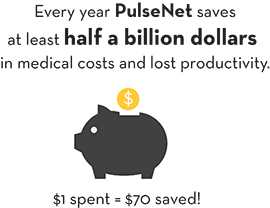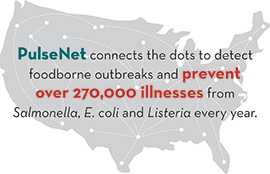PulseNet Saves Lives and Money
Download Fact Sheet: PulseNet Saves Lives and Money [PDF – 2 pages]
CDC’s laboratory network prevents 270,000 foodborne illnesses every year
 PulseNet, the national laboratory network that detects foodborne disease outbreaks, prevents an estimated 270,000 illnesses every year from the three most common causes of foodborne illness: Salmonella, E. coli O157 and Listeria monocytogenes. As a result, an estimated $507 million is saved every year in medical costs and lost productivity.
PulseNet, the national laboratory network that detects foodborne disease outbreaks, prevents an estimated 270,000 illnesses every year from the three most common causes of foodborne illness: Salmonella, E. coli O157 and Listeria monocytogenes. As a result, an estimated $507 million is saved every year in medical costs and lost productivity.
A recent economic evaluation of PulseNet activities from 1994 to 2009 shows the exceptional cost-effectiveness of this network. PulseNet costs public health agencies $7.3 million annually. But it provides an economic benefit about 70 times greater than its cost by quickly identifying problems in the food supply that would not otherwise be recognized. This fast detection of problems leads to prompt actions to stop foodborne outbreaks, prevent additional people from getting sick, and save lives.
PulseNet helps make our food safer
Outbreak investigations supported by PulseNet help identify problems in food production and distribution systems—for example, ground beef, nut butter, and cookie dough. These investigations have led to changes in food production and new federal recommendations – all of which are making our food safer to eat. PulseNet also speeds up identification and recalls of tainted foods.
What is PulseNet?
 PulseNet is a network of federal, state, and local public health laboratories that work together to rapidly identify foodborne disease outbreaks. PulseNet provides laboratories and disease detectives across the country with the information they need to investigate these outbreaks. Scientists use PulseNet data to compare the DNA fingerprints of germs from sick people to determine if they match. They then use these matching DNA fingerprints to link foodborne illnesses that are occurring in different areas of the country and detect outbreaks that otherwise may have gone unrecognized.
PulseNet is a network of federal, state, and local public health laboratories that work together to rapidly identify foodborne disease outbreaks. PulseNet provides laboratories and disease detectives across the country with the information they need to investigate these outbreaks. Scientists use PulseNet data to compare the DNA fingerprints of germs from sick people to determine if they match. They then use these matching DNA fingerprints to link foodborne illnesses that are occurring in different areas of the country and detect outbreaks that otherwise may have gone unrecognized.
Technological advances are making PulseNet even more precise, helping find more outbreaks when they are smaller and stop them quickly. CDC is committed to using cutting-edge technology to find foodborne disease outbreaks, and PulseNet and its partners will continue to stop foodborne outbreaks and protect the public’s health.
- Page last reviewed: March 1, 2016
- Page last updated: March 1, 2016
- Content source:


 ShareCompartir
ShareCompartir